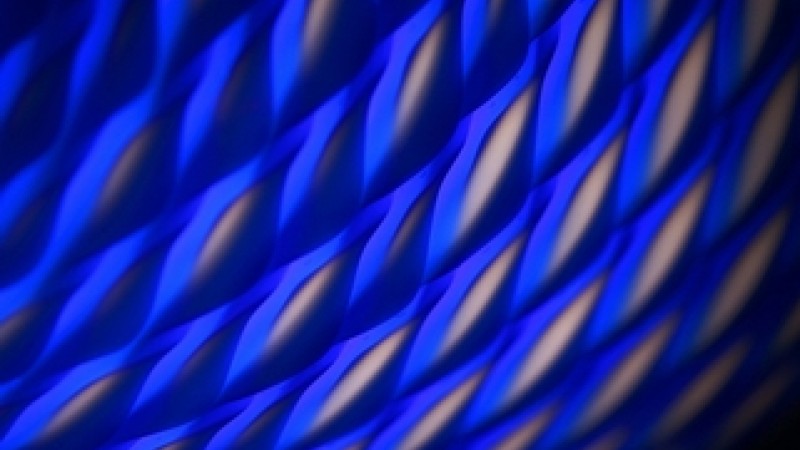Neutron scattering studies of "cobalt blue," a compound prized by artists for its lustrous blue hue, are revealing unique magnetic characteristics that could answer questions about mysterious properties in other materials.
Experiments at the Spallation Neutron Source (SNS) and High Flux Isotope Reactor (HFIR), both located at the U.S. Department of Energy's Oak Ridge National Laboratory, indicate novel behaviors in the antiferromagnetic material cobalt aluminum oxide (CoAl2O4), or cobalt aluminate, which researcher Gregory MacDougall of ORNL's Neutron Sciences Directorate describes as a "highly frustrated magnetic system."
"Frustrated" in this context refers to a condition where competing interactions between the magnetic spins within the atomic structure prevent the establishment of a long-range ordered state.
"Frustration is often associated with exotic behavior in materials, including piezoelectricity, multiferrocity, and high-temperature superconductivity, each of which is potentially important for future energy-efficient technologies," MacDougall said.
Antiferromagnetism is a type of magnetic order commonly found in materials below a certain temperature where the microscopic magnetic moments (often called "spins") on neighboring atoms align with their north and south poles oriented in opposite directions. Long-range antiferromagnetic order is technologically important for magnetic information storage.
The single-crystal experiments performed at ORNL showed the magnetic properties of cobalt aluminate exhibited drastic changes at the numbingly low temperature of 6.5 Kelvin. The experiments showed that effects from competing interactions may be responsible for its intriguing but poorly understood magnetic properties.
"Cobalt blue demonstrates behaviors that have never before been appreciated in a frustrated magnet, but have been seen in other materials," MacDougall said.
"Typically, frustration in the lattice from different energy scales and competing interactions drives the ordering temperature down. What we've found is, instead of eliminating ordering entirely, the long-range order is broken up into several small domains, in which the motion of the domain walls is frozen into place," MacDougall said.
Sharp walls separate those smaller atom-scale domains, set apart by the orientation of the atoms' magnetic spin. The result of freezing such walls into place is a glass-like behavior, normally indicative of highly disordered structure.
In cobalt aluminate's case, however, the glass-like behavior is exhibited on a very clean, ordered crystal. "We think this may explain unexpected glass-like behavior in other frustrated systems," MacDougall said.
The research, reported in Proceedings of the National Academy of Sciences, is part of a larger program to study magnetic frustration—what happens in magnetic systems when the geometry of the system or competing interactions frustrate or suppress the interactions that normally drive order, allowing novel behaviors to emerge.
"This is where you discover new physics," MacDougall said.
Cobalt aluminate is the compound responsible for cobalt blue, a vivid pigment used in paintings, colored glass and even to color concrete.
"In the past seven or eight years people have become interested in cobalt blue's magnetic properties because it turns out to be a prototypical system where competing interactions suppress magnetic order, and it is predicted to have novel ground states," MacDougall said.
The experiments were performed on two of HFIR's Triple Axis Spectrometers and the SNS's Cold Neutron Chopper Spectrometer (CNCS), making use of both thermal and "chilled," low-energy neutrons to study the cobalt aluminate at low, near absolute-zero temperatures. The single-crystal samples were fabricated in collaboration with ORNL's Correlated Electron Materials group.
MacDougall and colleagues used the triple-axis spectrometers at HFIR to study the ordering pattern of the cobalt blue lattice, which revealed the smaller domains forming at low temperatures. With SNS's CNCS, the researchers were able to study how long-lengthscale perturbations in the magnetic ordered states, known as "spin waves", moved through the system. The speed of those spin waves in different directions is a sensitive measure of the strength of the interactions between atoms in the cobalt blue system.
This research was funded by the U.S. Department of Energy (DOE) Office of Basic Energy Sciences.
UT-Battelle manages ORNL for DOE's Office of Science.
Published Work
Gregory J. MacDougall, Delphine Gout, Jerel L. Zarestky, Georg Ehlers, Andrey Podlesnyak, Michael A. McGuire, David Mandrus, and Stephen E. Nagler, "Kinetically inhibited order in a diamond-lattice antiferromagnet," PNAS, September 6, 2011, early edition.





